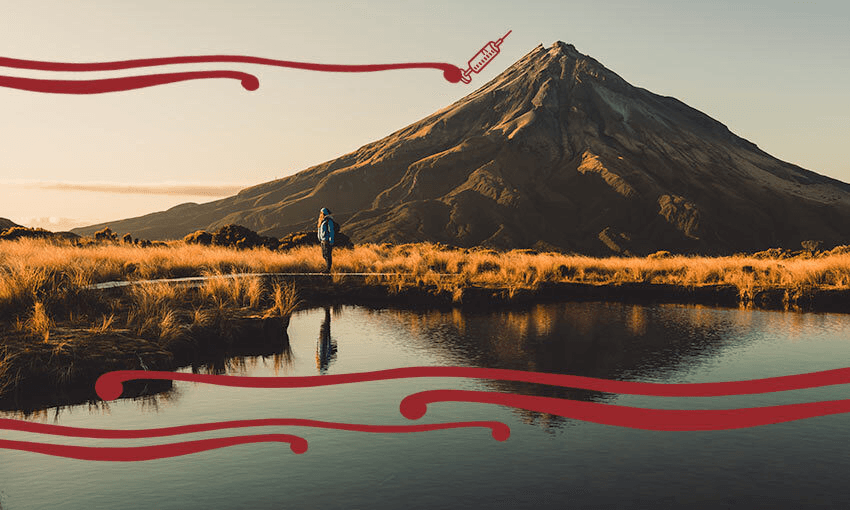When Covid arrived in Taranaki, iwi worked together to empower their uri – and managed to turn around the lowest Māori vaccination rates in the country.
There is a pou in Ngāmotu that guards the graves of those lost to the 1918 pandemic, a black monument adorned with a gold cross overlooking Port Taranaki. In alabaster-white text, it reads, “Here on these sacred grounds – lies the resting place of unknown loved ones who died from the Great Flu Epidemic in Taranaki.” Behind the pou stretches a long field of green, its rear boundary not visible from the roadside, the urupā disappearing behind two modest peaks. Across the motu, the 1918 pandemic claimed more lives in two months than any other event in our history: 8,600 men, women and children. For reasons related to housing and nutrition, among many other factors made worse by government action and inaction, it was Māori who were most affected. They suffered one of the world’s highest mortality rates, eight times greater than that of Pākehā. Between October and December of 1918, 4% of the Māori population lost their lives.
It was in the long shadow of this history and the first wave of Covid-19 in New Zealand that Ngā Iwi o Taranaki, spanning Waitara to Waverley, formed a union. Te Aranga o Taranaki is a body built to guard against history’s repeating itself and propel its uri into the future. Recognising what went wrong a hundred years ago, Ngā Iwi o Taranaki came together and agreed to find a way forward.
“They knew during the first lockdown that Covid would impact whānau not only from a health perspective,” Te Aranga o Taranaki iwi recovery manager Emere Wano said over the phone from Waitara, “but also from an oranga and an economic perspective. They didn’t want to be playing catch-up, they wanted to be ahead of the game in preparation for [Covid] being ongoing.”
And so, Te Aranga formed a strategy supported by seven heke: collective leadership, quality environments, future knowledge, healthy living, self-sustaining communities, connected culture and wealth creation. The collective understood that to combat the virus effectively, all eight iwi had to align their plans of action, to work across tribal territories, to ensure that their uri, regardless of where they were located, had their many kete catered to. This included having the resources to stay at home when required to isolate; having a home to isolate in; having the social and cultural connection to manage the fear, uncertainty and doubt that surrounds the pandemic; knowing there are people they trust who they can turn to if they need to kōrero; request something they’re missing; and get tested or get vaccinated.
Elaborating on the latter over a video call, Tui Ora w’ānau ora general manager Tamara Ruakere said, “It’s about whanaungatanga and manaakitanga. It’s about getting familiar faces in front of our whānau and getting what they need wherever they need it.”
The success of this approach was demonstrated when a positive Covid case was confirmed in a local primary school in Marfell. Working closely with Te Aranga, Tui Ora mobilised with incredible speed to meet a surge in the interest for vaccination, establishing testing stations at the school in question and collaborating with Ngā Iwi o Taranaki to ensure whānau knew where, when and how they could access these services.
“[Te Aranga and its partners] are not here to debate with our people over choices,” Emere Wano went on to say. “We are here to say these are your choices around vaccination, around testing, around where to go for support and for awhi.”
Throughout the whole of the pandemic, the collective has over and over again demonstrated the power of this approach and their unique capacity to empower their uri. For Ngāti Ruanui on the southern side of the rohe, this meant getting on the phone and calling whānau whare by whare to talk through their choices, opening walk-in clinics that required no booking, rolling out koha for those who got vaccinated, mobilising their kaimahi when positive cases emerged, establishing a mobile vaccination programme, increasing accessibility to the vaccine and providing a place where whānau could come to talk through their concerns. Kaiw’aka’aere of Te Rūnanga o Ngāti Ruanui, Rachael Rae, even went as far as to train with health professionals to learn both how to deliver a Covid test and the vaccine, providing further reassurance to all uri who needed it.
For the enormity of their efforts, Te Aranga and its partners have taken Māori in Taranaki from being the least vaccinated in the country in September of last year to now being 90% partially vaccinated and 85% fully vaccinated. This is without mentioning the number of whānau who without them would not have been able to access testing or the resources required to live well and when required, isolate safely in their homes. Though there’s still work to do, for Ngā Iwi o Taranaki’s mahi, the region is a world away from where it was in 1918.
This piece uses Taranaki dialect.
Airana Ngarewa is a Māori political affairs reporter, creating public interest journalism funded through NZ On Air.



